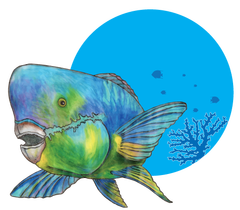AFIO MAI!
This 40th U.S. Coral Reef Task Force Meeting will be held in the heart of the South Pacific Ocean,
American Samoa, home to the largest coral head in the world.
August 13-16, 2018, Pago Pago, American Samoa
Business Meeting: August 15-16
The USCRTF includes leaders of 12 Federal agencies, seven U.S. States, Territories, Commonwealths,
and three Freely Associated States. The USCRTF helps build partnerships, strategies, and support for
on-the-ground action to conserve coral reefs
Registration Now Open
Please register by June 30th
Click Here
About the U.S. Coral Reef Task Force
The United States Coral Reef Task Force (USCRTF) was established in 1998 by Presidential Executive Order 13089 to lead U.S. efforts to preserve and protect coral reef ecosystems. The USCRTF has been instrumental in building partnerships and strategies for on-the-ground action to conserve coral reefs. The USCRTF works in cooperation with State, territorial, commonwealth, and local government agencies, nongovernmental organizations, the scientific community, and commercial interests to further the understanding and conservation of coral reef ecosystems.
The USCRTF has been instrumental in building partnerships and strategies for on-the-ground action to conserve coral reefs. The USCRTF works in cooperation with State, territorial, commonwealth, and local government agencies, nongovernmental organizations, the scientific community, and commercial interests to further the understanding and conservation of coral reef ecosystems.
For more information on the Task Force and its past meetings, visit: http://www.coralreef.gov/
The Samoan Archipelago consists of a remote chain of 13 islands and two atolls located 14 degrees south of the equator. The U.S. Territory of American Samoa and the neighboring independent country of Samoa, formerly known as Western Samoa are divided into two political entities. American Samoa includes 5 volcanic islands: Tutuila, Aunu’u, Manu’a Islands: Ofu, Olosega, and, Ta’u surrounded by fringing reef and 2 coral atolls, Swains & Rose. Tutuila is the main and largest island. American Samoa’s coral reef ecosystems are home to roughly over 2,700 marine species of corals, invertebrates,and fishes. The coral reefs of American Samoa are culturally, economically, and ecologically important to the Territory.
The USCRTF has been instrumental in building partnerships and strategies for on-the-ground action to conserve coral reefs. The USCRTF works in cooperation with State, territorial, commonwealth, and local government agencies, nongovernmental organizations, the scientific community, and commercial interests to further the understanding and conservation of coral reef ecosystems.
For more information on the Task Force and its past meetings, visit: http://www.coralreef.gov/
The Samoan Archipelago consists of a remote chain of 13 islands and two atolls located 14 degrees south of the equator. The U.S. Territory of American Samoa and the neighboring independent country of Samoa, formerly known as Western Samoa are divided into two political entities. American Samoa includes 5 volcanic islands: Tutuila, Aunu’u, Manu’a Islands: Ofu, Olosega, and, Ta’u surrounded by fringing reef and 2 coral atolls, Swains & Rose. Tutuila is the main and largest island. American Samoa’s coral reef ecosystems are home to roughly over 2,700 marine species of corals, invertebrates,and fishes. The coral reefs of American Samoa are culturally, economically, and ecologically important to the Territory.
For more information or general inquiries Contact Us.

